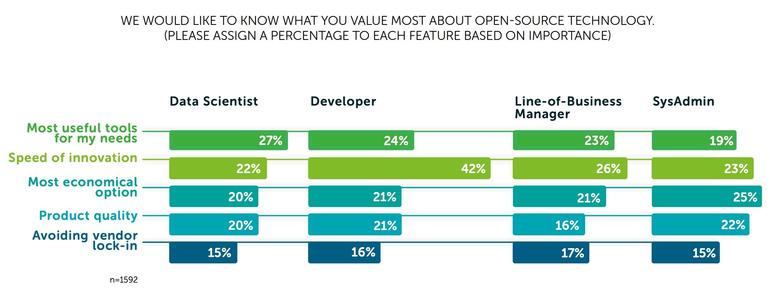Commentary: A new survey suggests many get it wrong when they assume companies choose open source to avoid lock-in.

Image: Getty Images/iStockphoto
Every enterprise uses open source, but the reasons for doing so often vary depending on one’s role within the enterprise. Anaconda, a popular data science platform with over 20 million users, surveyed its users to better understand the current state of data science adoption, including open source’s role therein. Among other findings, developers value open source so they can get work done right now, while their colleagues may value the price tag or utility.
But exactly no group puts “avoiding vendor lock-in” as their first (or even fourth) consideration for using open source. Open source can help companies achieve multi-cloud strategies, but by itself open source doesn’t magically make any workload portable. That’s simply not how open source (or enterprise) software works.
The good news is that no one seems to be waiting around on the “avoiding lock-in” argument.
SEE: How to build a successful developer career (free PDF) (TechRepublic)
Vendor lock-in: Who is talking about it?
As noted in the report, the survey respondents were asked to assign a proportional value to each of five commonly-cited benefits of open source software. Of the five, “most suitable tool for my needs” and “speed of innovation” claimed the most points, with “avoiding vendor lock-in” scraping into last place (Figure A).
Figure A

Image: Anaconda
If you’ve been paying attention to open source over the years, these numbers won’t be surprising. The closer the respondent is to the code itself, the more they care about the speed of innovation that open source enables, and the less they fret about lock-in. “Lock-in” is something vendors talk about–customers don’t seem to obsess over it in the same way.
Don’t believe me? Over the past few decades while open source has been booming, we’ve seen proprietary databases, ERP systems, etc. boom right alongside it. Indeed, over the 20 years I’ve worked for open source companies, I have almost never had a customer “vote” against lock-in with their wallets.
This is not to say that companies aren’t buying into open source in a big way–they are. It’s just that “no lock-in” is the puniest of reasons for doing so.
Innovating with open source
Instead, organizations have long chosen open source to save money while boosting innovation, with the latter reason by far the more compelling. You’d struggle to find companies using TensorFlow to help with their machine learning aspirations because “it’s free”–they use it because it’s a great way to do things like fraud detection, as PayPal has found. Others like Twitter turn to Redis not because it’s free, but because it helps the company achieve dramatic scale.
And so on.
Developers, closest to the code, figured this out long ago–that’s why they picked “speed of innovation” at roughly twice the rate of any other open source benefit. I recently discussed whether open source drives business innovation with Weaveworks CTO Cornelia Davis: “No one cares about lock-in if the software isn’t very good. The first order of priority is that most want super innovative software.” That’s what open source increasingly delivers.
Disclosure: I work at AWS, but this article reflects my views, not those of my employer.
Also see
Source of Article



